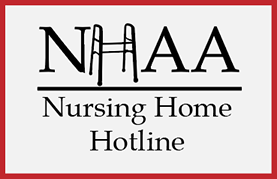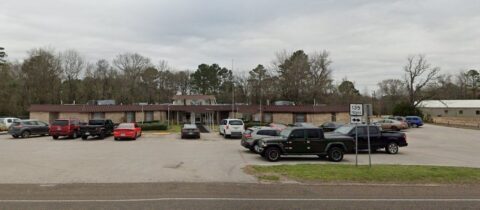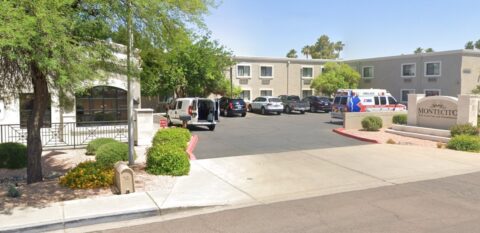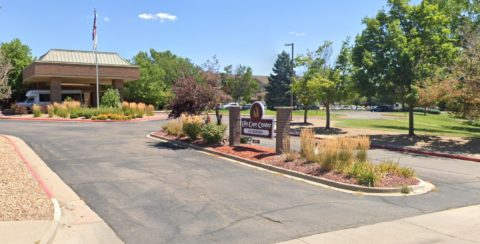State Findings:
Provide basic life support, including CPR, prior to the arrival of emergency medical personnel , subject to physician orders and the resident’s advance directives.
**NOTE- TERMS IN BRACKETS HAVE BEEN EDITED TO PROTECT CONFIDENTIALITY** 19401
Based on observation, interview, and record review the facility failed to provide basic life support, including CPR to a resident requiring emergency care prior to the arrival of emergency medical personnel and subject to related physician orders and the residents advanced directives for 1 of 4 residents reviewed for emergency care ( Resident #1)
The facility failed to assess and immediately initiate CPR when Resident #1, who was a full code, was found unresponsive in the dining room on [DATE] at 7:10 a.m. CPR was not initiated until EMS arrived (12 minutes after the resident was found unresponsive). Resident #1 was transported to the hospital, found to have large amounts of solid food in his airway, and pronounced deceased on [DATE] at 9:18am.
An Immediate Jeopardy (IJ) was identified on [DATE]. The IJ template was provided to the facility on [DATE] at 6:10 p.m. While the IJ was removed on [DATE], the facility remained out of compliance at a scope of isolated and a severity level of potential for more than minimal harm that is not immediate jeopardy due to the facility’s need to complete in-service training and evaluate the effectiveness of the corrective systems.
These deficient practices could place residents at risk for not receiving immediate emergency services (CPR) and death.
Findings included:
Review of Resident #1’s face sheet with undated indicated he was a [AGE] year-old male initially admitted to the facility on [DATE] and his last readmitted was [DATE]. Some of his diagnoses were stroke, cognitive communication deficit, and seizure disorder.
Record review of quarterly MDS dated [DATE] indicated Resident #1’s cognitive status was severely impaired with a BIMS score of 5. He required substantial to maximal assist with eating, and oral hygiene. He was dependent for all other ADLs.
Record review of Resident #1’s care plan dated [DATE] indicated the following care areas:
*At risk for choking related to seizure disorder requiring medications problem start date of [DATE] and last edited on [DATE] . The approaches were to monitor the resident frequently throughout the shift following seizure activity. To assess the resident after seizures, the time, length, level of consciousness, activity, and respiratory activity if a seizure occurred.
*A mechanical soft diet due to a history of stroke with residual effects and contractors to bilateral hands problem start date of [DATE] . The approaches may have clothes protector during meals if desired, ensure a bedside table was provided in the ding area with meals for easy reach. Report problems to charge nurse such as choking or difficulty chewing. Someone to assist with feeding on days he had difficult feeding himself.
*An advance directive problem start date of [DATE] and last edited [DATE]. The approach was full code. Record review of Resident #1’s computerized physician orders indicated the following:
*dated [DATE] for Full Code Status.
*dated [DATE] for regular diet, mechanical soft with thin fluids.
Record review of an EMS report dated [DATE] indicated at 7:16 a.m. dispatch received a call. The EMS were in route at 7:17 a.m. and arrived on the scene at 7:20 a.m. The report indicated they were at the patient at 7:22 a.m. and departed the scene at 7:30 a.m. The report indicated they were at the hospital at 7:37 a.m.
The report indicated the Resident’s primary impression was cardiac arrest with a reported-on set of 7:10 a.m. and a duration of 12 minutes. The report indicated on arrival on the scene they asked for directions to the patient, and the nursing staff pointed to a resident sitting in a wheelchair. The nurse who gave report stated he had breakfast at about 6:30 a.m. and when she approached him at 7:10 a.m. he was not responsive.
There was no CPR initiated prior to EMS arrival. At 7:22 a.m. initial contact with the resident showed he was unresponsive, pulseless, and warm to touch.
Record review of hospital records dated [DATE] indicated Resident #1 arrived at 7:38 a.m. with a diagnosis of Cardiac arrest with pulseless electrical activity. Resident #1’s airway was assessed per guided scope and found to have large amounts of solid food throughout visible airway. The food products were noted in King airway( a tube used for intubation for advanced airway management) as well. Attempts to clear the airway via mechanical and suction removal. EMS stated the patient was sitting in a wheelchair at the nurse’s station unresponsive with no CPR in progress when they arrived. The patent had just eaten breakfast. The exact down time is unknown. We were unable to replace the laryngeal mask airway ( LMA a medical device that keeps a patient’s air way open while they are unconscious) due to the amount of food in his trachea. (Windpipe ). The patient was pulseless from the time of arrival to the time the MD pronounced him deceased. Compressions were stopped at 8:45 a.m. and he was pronounced by the physician at 9:18 a.m. as deceased .
Record review of Resident #1’s nursing note dated [DATE] with a time of 7:50 a.m. but was created on [DATE] at 3:41 p.m. indicated, Resident #1 was up in his Geri-chair in the dining room for breakfast between 6:30 a.m. and 7:00 a.m. He was sitting up joking with the other residents in his usual manner. He consumed about 90 percent of his meal which consisted of oatmeal, eggs, and a biscuit. Kitchen Stall D, Kitchen Staff E and LVN B remained in the dining area while this nurse (LVN A) assisted another resident to his room. When nurse returned to the dining area Kitchen Staff D was loudly calling Resident #1’s name and tapping him. The nurse performed a sternum rub and he did not respond. He had a significant history of seizures, hypoglycemia, and cardiac arrest. The nurse asked Kitchen Staff D to get LVN B and call 911 for help. LVN B called 911 and came to assist this nurse. The nurse proceeded to check the code status( to determine If he was a do not resuscitate or to perform CPR) and gather items needed to assess the resident while LVN B pushed the resident to the nursing station. Resident #1 was a Full Code( indicated the resident wished for
the facility to provide every possible effort to save his life in a medical emergency including CPR). The nurse was unable to get vitals or arose the resident per verbal or tactile stimulation. EMS arrived and initiated CPR. The note indicated the responsible party was notified at 7:19 of the transfer to the hospital. and another entity was notified at 7:18 a.m. The note was written by LVN A.
Record review of a nursing note dated [DATE] at 9:20 a.m. indicated the facility contacted the family for a report on Resident #1 and as informed the resident had expired.
Record review of a timeline provided by the facility on [DATE] at 3:40 p.m. by the administrator undated indicated on [DATE] between 6:30 a.m. and 7:00 a.m. breakfast was served. LVN A was located in the dining room until 6:50 a.m. when she left to walk a resident back to his room and check on another resident. LVN B was in the dining room until approximately 7:00 a.m. and then gathered smokers to take them out to smoke. At 6:50 a.m. Kitchen Staff D and Kitchen Staff Kitchen Staff were eating their breakfast in the dining room. At 7:10 a.m. smokers came back inside, and Resident #1 appeared to be sleeping. Kitchen staff D went to Resident #1 to take him to the lobby and could not get him to respond. Staff loudly called his name, and LVN A overheard Kitchen Staff D talking to Resident #1 and walked into the dining room. At 7: 14 a.m. LVN A told
LVN B to call 911. LVN B dial 911 and handed the phone to CNA C. Then LVN B returned to the dining room with LVN A. LVN A went to the nurse’s station to verify Resident #1’s code status and get things to check Resident #1’s vitals. LVN B then pushed Resident #1 to the nurse’s station after she was unable to get vital signs and he did not respond to a sternal rub. EMS arrived at approximately 7:20 a.m. and left the facility at approximately 7:28 a.m. with CPR in progress. Verbal statements from the staff indicated CNA C said she was asked by LVN B to speak with 911 between 7:10 a.m. and 7:14 a.m. During interviews Kitchen Staff D and Kitchen Staff E said between 6:30 a.m. and 7:00 a.m. they served breakfast. They said that LVN A was in the dining room sitting with residents. They said that LVN B took the smokers out to smoke between 7:00
a.m. and 7:10 a.m. Kitchen Staff D said she went over to Resident #1 to push him to the lobby to help nurses out like she always did while Kitchen Staff E went back into the kitchen. Kitchen Staff D said she could not arouse Resident #1. She said she called his name loudly and LVN A came in the dining room. LVN A said she asked Kitchen Staff D to get LVN B and to call 911. LVN A said EMS arrived at approximately 7:15 a.m. to 7:20 a.m. Resident #2 said Resident #1 was sitting up and talking and joking like he always did. She said she went out with the smokers at 7:00 a.m. for smoke break. She said when she returned from smoking Resident #1 appeared to be sleeping. She said Kitchen Staff D was standing with him, calling his name, and shaking him and LVN A came into the dining room. There was no signature on the typed note.
During an interview on [DATE] at 4:50 p.m. a concerned citizen said the facility failed to put life saving measures in place to prevent Resident #1 from dying. They said on [DATE] at about 7:30 a.m. EMS arrived, and a full code resident was sitting in a chair, with nurses standing around not performing CPR. They said EMS was informed by a nurse Resident #1 had been unresponsive since 7:10 a.m. They said Resident #1 was still in the chair and facility staff did not perform CPR to try and save the resident’s life.
During an interview on [DATE] at 7:47 a.m. the Dietary Manager said she worked [DATE] as a CNA. She said she heard Kitchen Staff D calling for LVN A. She said Kitchen Staff D told her Resident #1’s lips were blue when she approached him. The Dietary Manager said the two kitchen aides that worked on [DATE] Kitchen Staff D and Kitchen Staff E She said when she walked up front on the morning of [DATE] someone had brought Resident #1 up to the front and CNA C was on the phone with 911. She said LVN B had the Resident #1 in the Geri-chair and LVN A was behind the nurse’s station.
During an interview on [DATE] at 7:55 a.m. LVN A said Resident #1 was found in the dining room
unconscious. She said she was headed back to the dining room when she heard Kitchen Aide D screaming and calling her name. She said when she went into the dining room Resident #1 was unresponsive, she shook him, did a sternal rub, and did not get a response. LVN A said she asked Kitchen Staff D to get LVN B. She said LVN B called 911. LVN A said she did not notice Resident #1’s color or take his pulse. When LVN B arrived, she went to check his code status she did not want to initiate CPR if he was a DNR. She said they did not call for the crash cart. While she was at the nurse’s station about 2 minutes, LVN B brought Resident #1 up to the nurse’s station. She said just about that time EMS walked in the facility. EMS took Resident #1 out of his chair, put him on the gurney, and initiated CPR. LVN A said Resident #1 was a Full Code. She said Resident #1 did not require assistance with eating, but he had a mechanical soft meat. She said he was sitting at the table by himself with a tray table sit up just for him. She said Breakfast stated about 6:30 a.m. and she left about 6:50 a.m. to go and assist another resident to his room. She said Resident #1 had a history of heart attacks. She said he was in a Geri chair, and she checked the status by looking in her book at the nurse’s station. She said the crash cart was located on hall 3, but she never sent for it. She said LVN B checked Resident #1’s pulse. LVN A said when EMS arrived it was 4 or 5 EMS workers, and they asked when the last time Resident #1 was responsive. She said she told them it was about 7:10 a.m. She said she was behind the nurse’s station when EMS arrived and LVN B handed Resident #1 off to EMS. LVN A said she called the ADON/RN on the way to the nurse’s station to let her know what was going on. LVN A said she had been a nurse for less than a year, Resident #1 was her first medical emergency. She said ADON/RN had educated them on doing CPR no matter what. LVN A said she was not sure of the exact time frame because everything appeared to go so fast, but it was at least 5 minutes maybe 10 minutes form the time she saw the resident in the dining room until EMS arrived.
During an interview on [DATE] at 8:15 a.m. the Administrator said they had completed a timeline regarding Resident #1. They had investigated the incident and taken statements from staff. She said their investigation did not determine any abuse or neglect, so they had not called the incident into the state. She said they had tried to get hospital records but were unable to do so. She said the EMS company was right down the road less than 5 minutes from the facility and they arrived almost immediately after being called.
During an interview and observation on [DATE] at 8:17 a.m. LVN B said on [DATE] most residents had finished eating and had left the dining room or been taken to their rooms. She said LVN A left the dining room to take a resident back to his room. She said around 7:00 a.m. there were only two
residents left in the ding room, Resident #1, and Resident #2. LVN B said at about 7:00 a.m.
someone wanted her to take them out to smoke. She said when she walked outside Resident #1 was
drinking his coffee. She said he had a little food on his plate. LVN B said when she came back
inside after about 10 minutes, she did not really look at Resident #1. She said she had one
resident to push inside, and she had the cigarette box. She said she was at the nurse’s station,
and she heard Kitchen Staff D yelling for her. LVN B said as she was on her way, she heard LVN A
and heard both say come here. She said LVN A called for her, heard her say call 911. LVN B said she
called 911 and had CNA C to hold the phone with EMS. She said when she arrived in the dining room Resident # 1 was laid back in his Geri chair, she did see a blue [NAME] to his lips. She said LVN A went to get blood pressure cup and pulse ox. LVN B said she did a sternal rub, she checked Resident #1’s pulse at his wrist and neck, and he did not have a pulse. She said she was probably with the resident about 2 minutes after LVN A left. She said LVN A did not return. She said she did not initiate CPR. LVN B said she took Resident #1 to the nurse’s station in his Geri chair. LVN B
pointed out where the resident was in the dining room which was close to the exit door for the
smokers.
Observations and interview indicated it was about 100 feet across the dining room to the door and
about 5 to 7 feet from the door to the nurse’s station. LVN B said the whole process took 5 to 6
minutes. She said no one got the crash cart and she did not request the cart. She said when she got
Resident #1 to the nurse’s station EMS arrived. LVN B said EMS pulled Resident #1 out of the chair
put on gurney and started doing compression right there in the hallway. She said EMS did not ask
her any questions, they asked LVN A for a face sheet. LVN B said at school she was taught you did
not start CPR until after you verified code status. She said she had been a nurse since [DATE], and this was her first job. She had done CPR but only on a dummy, and Resident #1 was her first code. LVN B said she was in serviced after the incident on [DATE] by ADON/RN who said you start CPR first and then check the code status.
During an interview on [DATE] at 8:28 a.m. LVN A said she noted Resident #1’s color was off, she
did not note anything about his lips being discolored.
During an interview on [DATE] at 8:30 a.m., ADON/RN said she came to the facility on [DATE] after the Resident #1 was taken to the hospital. She said she got a call from LVN A on [DATE]. She said her telephone log indicated that call was received at 7:18 a.m. and she was on the phone about two minutes with LVN A. She said when she arrived at the facility, she did in services on emergency
procedures and providing CPR. ADON/ RN said she could not say that anyone did anything wrong she just felt that the staff needed education.
During an interview on [DATE] at 9:00 a.m. CNA C said she worked at the facility for [AGE] years,
and was at the facility on [DATE]. She said she was coming the hall brings something to the dining room. She said she heard Kitchen Staff D yell for LVN A to come to the dining room and run. CNA C said when she made it to the nurse’s station LVN B was running to nurse station to call 911. She said LVN B gave the phone to her and told her what to tell dispatch. She said LVN B said they had a
resident that was unresponsive, and he was in the dining room. CNA C said while she was still on
the phone LVN A came to the Nurses station to see if Resident #1 was full code or DNR. She said LVN A looked on the computer. CNA C said LVN A was on her cell phone talking to ADON/RN. She said she did not know how long LVN A was at the nurse’s station, she turned her back while still on the phone with EMS dispatch. She said LVN B brought Resident #1 to the nurse’s station still in the
Geri chair. CNA C said LVN B asked her to take him to his room while she was still on the phone.
CNA C said when Resident #1 was brought to the nurse’s station she did not see his color, and no
one asked her to get the crash cart. She said after calling EMS they arrived about 5 minutes later.
CNA C said it might have been 10 minutes form the time of Kitchen Staff D was screaming to EMS got to the facility. CNA C said LVN A was behind the nurse’s station at that point. She said when EMS arrived, LVN B pointed to Resident #1 in the Geri chair. CNA C said EMS asked a few questions, they put Resident #1 on the stretcher, and initiated CPR. She said she did not write a statement; she did not see anyone taking vitals.
During an interview and observation on [DATE] at 11:05 a.m. LVN A revealed a book at the nurse’s
station. Observation of the book showed a couple of pages dated [DATE] with full code residents on
the first page and DNR residents on the second page. LVN A said they just updated the list
yesterday and that was the book she used to determine if Resident #1 was a full code. She said she
did not know how long she remained at the nurse’s station after checking but before she could get
back to the dining room, LVN B had brought Resident #1 to the nursing station. LVN A said just
about that time EMS walked in. She said that she had not taken Resident #1’s pulse or checked his
mouth to see if there was any food or blockage.
During an interview and observation on [DATE] at 11:07 a.m. with the ADON/LVN . The crash cart was located on hall 6 in a storage room. The cart had all the required supplies and on the crash cart was a list of Resident and their code status. The ADON/LVN said the list has always been on the crash cart. The ADON said the AED was located on the wall behind the nurse’s station. Observation of the AED showed it was on the wall with the pads right beside it. Also, a battery check of the AED showed it was in working order.
During an interview on [DATE] at 11:25 a.m. Resident #2 said she was in the dining room on the
morning of [DATE]. She said Resident #1 was his usually joking self. She said they went out to
smoke about 7:00 a.m. and he asked for another cup of coffee right before they left. Resident #2
said when they came back inside about ,d+[DATE] minutes later, Resident #1 was sitting in his chair and appeared to be asleep. Resident #2 said she spoke to Resident #1, but he did not speak back. She said it looked like he ate all his food, and sometimes he chokes when he eats, and he made noises in his throat when he ate. She said Kitchen Staff D went over to him and she could not get him to awaken so she started screaming. She said LVN A and LVN B came running. She heard them say something about code status, and they could not find a pulse. She said after a few minutes they took him out of the dining room.
During a telephone interview on [DATE] at 11:43 a.m. Kitchen Staff D said that she and Kitchen
Staff E were in the kitchen with the door closed. She said around 6:50 a.m. they went out to eat their breakfast in the dining room. She said when they first went into the dining room LVN B was there but had gone to get the smoking box for the residents. Then she took them out to smoke. Resident #1 was sitting at the table, and he looked like he was sleeping. She had gone to take him out of the dining room, she said she normally helped the aides get some of the residents out. She said when she had gone over, she could not get Resident #1 to respond, and his color was off. She called his name several times and she guessed LVN A heard her, she did not remember calling her name. Kitchen Staff D said the nurse came and told her to get LVN B. She said LVN B called 911. She did not know what happened after that she said it was 2 or three minutes and they had him up front and she knew the paramedics came and she went back into the kitchen.
During a telephone interview on [DATE] at 11:50 a.m. Kitchen Staff E said she and Kitchen Staff D
came out of the kitchen around 6:50 a.m. when they arrived in the dining room LVN A got up to take a resident back to their room. She said LVN B went to take the residents out to smoke. She said the whole time they ate their breakfast Resident # 1 appeared asleep. She said she left to go back in the kitchen at about 7:10 a.m. when she finished eating and Kitchen Staff D went to take Resident #1 out of the dining room. Kitchen Staff E said she did not hear any commotion and was only aware of the situation when Kitchen Staff D came back into the kitchen.
During an interview on [DATE] at 2:22 p.m. the Administrator and ADON/RN were informed of the concerns about the resident choking and no CPR being provided prior to EMS arrival. They said that EMS company was right down the street, and it did not take them long to arrive at the facility,
about 5 minutes. The Administrator said staff acted appropriately, they called 911. The staff did
what they were supposed to do.
During an interview on [DATE] at 2:55 p.m. LVN B said she did not look in Resident #1’s mouth. She said when they went out to smoke, he had a little food on his plate. She said there was a spoon or two of oatmeal and a small piece of biscuit. She did not look at his plate when they returned, or
the plate may have been removed. She said the resident did cough on occasion when he ate but she
had never seen him choke.
During an interview on [DATE] at 3:00 p.m. CNA C said Resident #1 coughed a lot it did not matter if he was eating or not. Sometimes he did cough when he was eating and cleared his throat quite a bit. She said he had done that for a long time, and it was nothing new.
During an interview on [DATE] at 3:05 p.m. p.m. CNA F said Resident #1 had a deep cough that would startle you. She said he did cough when he ate occasionally.
During an interview on [DATE] at 3:10 p.m. LVN A said she did not look in Resident #1’s mouth on
the morning of [DATE]. She had gone to get the supplies to complete his vitals. She had told EMS he had been unresponsive 5 to 10 minutes before they arrived.
During a telephone interview on [DATE] at 3:15 p.m. with the DON and ADON/RN, LVN A and the
Administrator was present. The DON said the nurses saw Resident #1 unresponsive and tried to arise him. She said LVN A went to the nurse’s station to get supplies. She said the resident had a
history of seizures and she likely thought he had a seizure.
Your Experience Matters
...and we want to hear it.
NHAA is here to assist families, residents, and the community by sounding the alarm on issues like those found above. This nursing home and many others across the country are cited for abuse and neglect.
If you have or had a loved one living in this nursing home or any other nursing home where you suspect any form of abuse or neglect, contact us immediately.
We have helped many already and we can help you and your loved one as well by filing a state complaint, hiring a specialized nursing home attorney or helping you find a more suitable location for your loved one.
You can make a difference, even if your loved one has already passed away.
Please give us a call at 1-800-645-5262 or fill out our form detailing your experience.
Personal Note from NHA-Advocates
NHAA shares with all the families of loved ones who are confined to nursing homes the pain and anguish of putting them in the care of someone else. We expect our loved ones to be treated with dignity and honor in the homes we place them. We cannot emphasize enough to family members of nursing home residents; frequent visits are essential to our loved ones’ well-being and safety.
If you are struggling and upset, click here to understand your options, or contact us through our contact form or call our toll free hot line number: 1-800-645-5262.







